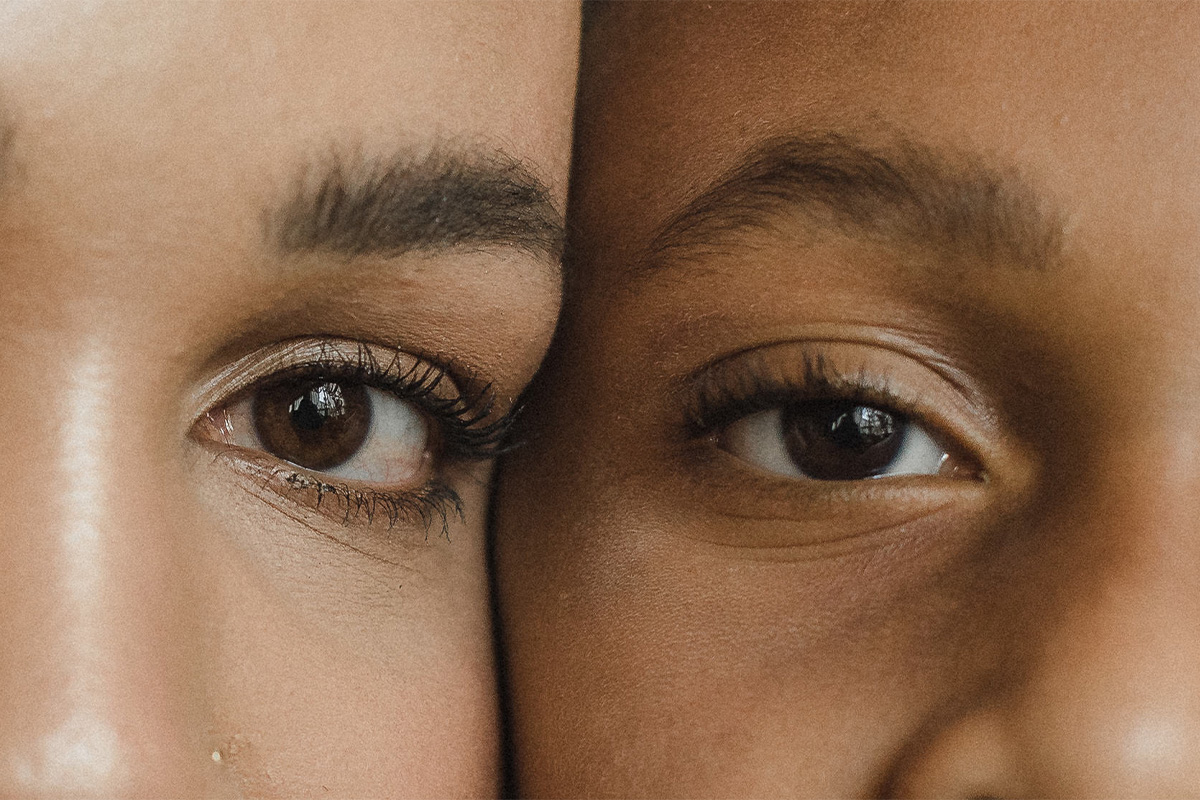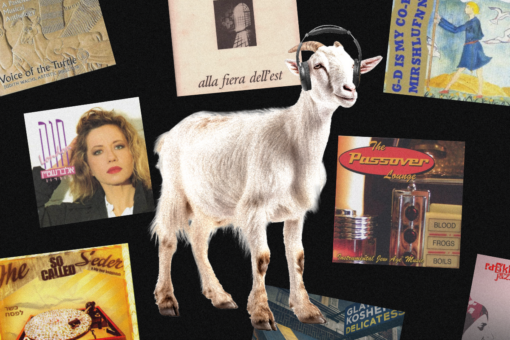Like another famous Canadian export, the short film “Periphery” begins with a tree.
The opening shot of the film shows a towering oak tree in High Park, in Toronto, on a bright sunny day. The camera glides over the tree’s serpentine branches and glistening green leaves as a voiceover describes: “You have things from all around, different, nourishing this one tree, and that makes it very, very difficult to say that it belongs to one thing or another…it’s of one place or another…and I think that’s true of any living thing.”
“Periphery” is a photographic and film project produced by two groups: No Silence on Race, a Canadian not-for-profit organization dedicated to platforming the experiences of Jews of Color in Canada, and the Ontario Jewish Archives, a local community archive that collects and preserves the historic record of Jewish life in Ontario.
The short film consists of ten interviews with members of Canada’s Jewish community, set to evocative music and interspersed with poetry excerpts and dance footage. The interviews focus on the experiences of Jews of Color in Canada, as well as those of recent converts, queer Jews, and Jews who possess multiple, intersecting identities.
One interviewee discusses their experience of being a “Jew in progress” while converting to Judaism. Another interviewee describes how her mixed Punjabi-Ashkenazi ethnicity informed her identity growing up. Each story showcases the experience of someone who might typically be relegated to the margins of discussions about Jewish culture and identity.
I sat down with Sara Yacobi-Harris, director and producer of “Periphery,” and Akilah Allen-Silverstein, a production assistant on the project, to discuss the film and how North American Jewish communities can make more space for the experiences of multi-ethnic Jews.
This conversation has been lightly edited and condensed for clarity.
How did you become involved with No Silence on Race and the “Periphery” project?
Sara: Following the murder of George Floyd in 2020, myself and other Jews of Color were being asked to speak on panels and roundtables and online discussions about being Black and Jewish, or discrimination in the Jewish community. It felt like a very reactive thing our community was doing. For me, I thought, “What else are we doing as a community?”
And so, in the months that followed, I started approaching some people that I know who identify as multi-ethnic Jews and asked, “I’m interested in writing an open letter to the Jewish community.” We [eventually] moved from an open letter with nine pillars to becoming a group with three key members: myself, Akilah, and Yoni Belete. We are trying to transform our advocacy through the lens of media, art, and education.
Akilah: I thought it would go on for a month or two and then we would go on with our lives, but it actually spiralled. We talked and talked with other synagogues. It became very clear that what we were missing in the community was content, history and experiences of Jews of Color.
How did you find the interview subjects for the project? How did it all come together?
Sara: The Ontario Jewish Archives approached us and asked if we would partner with them to produce a portrait series featuring Jews of Color in Ontario. We agreed to the portrait series and also pitched the idea of a short film to create the opportunity to have people tell their stories through in-depth interviews, in addition to the portraits. Our participants were selected through a community wide search process. This included word of mouth, through friends, colleagues and family members.
Many Jews and non-Jews have a preconceived image of what it means to be Jewish, usually associating all Jews with items specific to Ashkenazi culture and history, such as lox and cream cheese, Klezmer music or Yiddish phrases. In what ways does “Periphery” help us move beyond this narrow, “Ashkenormative” way of envisioning Jews and Judaism?
Sara: It’s about featuring different, diverse Jewish cultures. Whether it’s about their art, their cuisine, their traditions, how they celebrate life cycle events, differences and similarities.
The Jewish diaspora is huge. Jews have existed on almost every continent on the planet. So what does it mean to tilt the narrative from an Ashkenazi-centric narrative? There’s an Iraqi synagogue in Toronto, and there’s a Bene Israel synagogue for Indian Jews. There are these pockets of community that also have stories to tell, culture, books, and rich, vibrant histories. It’s about building that awareness inside our community so we can tilt the narrative both within and outside of Jewish life.
How did this work fit into the rest of your lives? Have activism and filmmaking always been at the centre of what you do?
Akilah: We all have day jobs. Yoni is an amazing PR consultant, I’m in financial planning, and Sara was at the Canadian Broadcasting Corporation in the film world. We were just speaking as members of the community, who live and work and do other things. We are not trying to be the voice of everyone or shift our day jobs to become full-time DEI consultants.
My day to day, I’m a financial planner. I like poetry, art, and film. It’s about storytelling. How do we tell these stories? I ended up doing a poem that’s featured in the film. For me, poetry is a reflective activity. It was fun to jump back in.
There are so many conversations right now about antisemitism, whiteness, and Jewish identity. How does this work fit into those conversations, and how do we discuss these topics honestly and openly?
Sara: The question for us is: How do we tell the story of Jewish diversity as a way to also combat antisemitism? There are antisemitic stereotypes, tropes and myths that exist about who Jewish people are. From our perspective, we are like hey, let’s shake up those misconceptions about who Jewish people are. Let’s present who Jewish people actually are — both in Canada but also on a global scale — as a different alternative to enter this conversation about antisemitism.
At the same time, the film touches on sexual identity, racial identity, conversion, intersectionality. There are a lot of topics in what we are presenting that are more palatable than others. Are certain audiences ready for what we talk about in “Periphery?”
Well, we have ten amazing people that reflect back how diverse we are as people and how we walk in the world. As a filmmaker, it’s my job to do justice to these people’s stories. It’s their stories to tell. We are choosing to see what we’re doing as our gift to the community for those who are willing to receive it.
What have been the reactions to “Periphery” so far? Do you have any favorite memories working on this project?
Akilah: My favorite memory is when after we did the screening of the film at my house, seeing the look on everybodys’ parents’ faces. A lot of the parents were first-generation immigrants who came to North America at 18, 25, 30. They’ve had a mix of experiences, some of them not so great, some of them good. We initially tried to get some of them in [the film]. There was a little bit more resistance to get them to talk about their experiences, but after we did the first screening, all the walls came down.
It was honestly just seeing their pride and seeing the floodgates open in telling us how proud they were and how long they were waiting to see something like this. [That would be my favorite memory, seeing this] first generation of Jews of Color of various backgrounds, and bringing them a sense of pride, validating their experiences and their childrens’ experiences.
Sara: So far we’ve received a lot of support for “Periphery.” We received enthusiasm, and a lot of “Oh my God, I had no idea!” There are people who have been a part of this space and have not had the resources or capacity to tell these stories, for whatever reason.
As Jews, we have been scattered across the globe, and we have diasporic communities across the globe. As Jews have a responsibility to understand and know these communities.
I think that is also an integral part of what it means to be Jewish: to know each other. I hope Periphery can also be a tool for students, for lifelong learners, and for Jewish community members, to know these histories and know their cultures such that we can build this awareness among ourselves. Then we can reflect that back into the outer world so other people also know who we are.
You can view “Periphery” here. More information about the Periphery Photo and Film Project, as well as the recently launched Periphery school curriculum, can be found here. To learn more about No Silence on Race, please visit their website.



